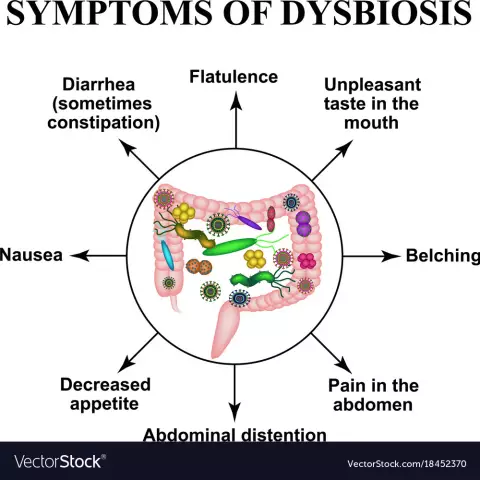- Author Rachel Wainwright [email protected].
- Public 2023-12-15 07:39.
- Last modified 2025-11-02 20:14.
Dysbacteriosis

Dysbacteriosis is a violation of the normal composition of the beneficial microflora.
It is known that normally the intestines of an adult are inhabited by a huge number of bacteria - about two kilograms, more than 400 species in total. The composition of bacteria is different, it depends on many factors, among which the predominant ones are nutrition and living conditions of a person, it will not be an exaggeration to say that the bacterial flora of the intestines of each person is unique. Intestinal bacteria are normally saprophytes, that is, useful cohabitants that perform an important function: they help to assimilate substances that are not assimilated in the upper gastrointestinal tract, without them the body receives less essential elements of proper metabolism, components of vitamins, enzymes are produced here, as well as immune defense factors.
The balance of microflora is very important, since each group of microorganisms provides its own area of useful activity. They talk specifically about the balance, since it is impossible to imagine the exact number of necessary microorganisms of one or another type, even for one person, since the composition of bacteria changes depending on the type of food, season, health and many other reasons.
An imbalance in the intestinal microflora is called intestinal dysbiosis.
In addition to intestinal dysbiosis, there is vaginal dysbiosis and oral dysbiosis, since both the vagina and the mouth also have their own microflora inherent in them. Its role in the body is somewhat less than the role of the intestinal microflora, but it is no less important for health. The most striking example of dysbiosis of the vagina or oral cavity is thrush, or candidiasis, a disease caused by the excessive reproduction of fungi of the genus Candida, which are normally suppressed by the bacterial component of the flora.
Intestinal dysbiosis is very often accompanied by other dysbiosis, since pathogenic factors usually affect the body as a whole.
Dysbiosis reasons
The cause of dysbiosis is the death of one or more components of the normal intestinal microflora. The most common causes of dysbiosis are as follows:
- Diseases of the gastrointestinal tract (cholecystitis, gastritis, enterocolitis, hepatitis, pancreatitis, etc.);
- Food and non-food poisoning;
- Antibiotic therapy is one of the most common causes of dysbiosis. Unreasonable, unjustified use of antibiotics, self-medication with antibiotics have led to an unprecedented increase in cases of dysbiosis. If the doctor prescribes antibiotics, he always takes into account the dysbiosis, and will take therapeutic measures to avoid it;
- Long-term use of hormonal drugs;
- Unbalanced nutrition, that is, such a diet that cannot provide the vital activity of groups of bacteria necessary for health.
Dysbiosis symptoms

Intestinal dysbiosis can be disguised as a variety of diseases, since it itself is often a consequence of diseases, and also provokes their occurrence and development.
The main symptoms of intestinal dysbiosis are signs of dyspepsia, primarily stool disorders. As a rule, there is a tendency to diarrhea or constipation, or alternating diarrhea with constipation. These phenomena are accompanied by flatulence, which is persistent, regardless of the food taken.
One of the most important symptoms of intestinal dysbiosis is a persistent decrease in immunity, which is expressed in susceptibility to infectious diseases. Also, the general condition worsens, chronic fatigue, rapid fatigability, weakness, decreased concentration and attention appear. With an increase in dysbiosis, signs of anemia may appear.
Symptoms of vaginal dysbiosis are itching, swelling, liquid foamy discharge, soreness and burning during and after intercourse.
Dysbacteriosis of the oral cavity manifests itself by the appearance of a jam in the corners of the mouth, stomatitis.
Diagnostics of the dysbiosis
The main analysis for dysbiosis is a bacterial examination of the contents of the intestines, vagina, and oral cavity.
An analysis for intestinal dysbiosis is a bacterial study of feces. Feces are sown on special nutrient media, then the qualitative and quantitative ratio of bacterial colonies is assessed.
Analysis for dysbacteriosis of the vagina - a smear from the vagina followed by bacterial examination, analysis for dysbiosis of the oral cavity - scraping from the mucous membrane, also with bacterial culture.
However, this study is not entirely informative, especially in the case of intestinal dysbiosis, since it allows assessing only the composition of the microflora of the terminal sections of the large intestine. Therefore, the diagnosis takes into account the history, symptoms of dysbiosis, general health and other signs.
Dysbiosis treatment

Treatment of dysbiosis is usually difficult and lengthy. First of all, it is necessary to eliminate the cause of dysbiosis, and to cure those diseases that led to it (if it is in them).
Secondly, proper nutrition is extremely important, and not only in the case of treating intestinal dysbiosis, but also for all other dysbiosis. Nutrition should be complete and balanced, and must include prebiotics - substances necessary for the nutrition of beneficial microflora. Prebiotics include fermented milk products, as well as foods rich in complex carbohydrates and fiber - vegetables, cereals, and wholemeal baked goods. Food that promotes putrefactive processes in the intestines is prohibited: heavy red meat dishes, fried, fatty, smoked foods. Confectionery and sugar (simple carbohydrates) are also prohibited.
Drug treatment of dysbiosis consists in the appointment of probiotics. Probiotics are freeze-dried (dried in a special way) colonies of beneficial bacteria. The diet should be long-term, if not lifelong, and probiotics are also given on a long-term basis. It should be understood that without changing the usual diet, one drug treatment of dysbiosis is unsuccessful, it will only lead to a short-term improvement.
Dysbacteriosis in children
Dysbacteriosis in children is no less frequent than dysbiosis in adults. The child is born sterile, not counting the bacteria that he "picks up", passing through the birth canal of the mother. From the very first hours of birth, his digestive tract begins to colonize with bacteria. Breastfeeding provides the baby with everything necessary for this: both the bacteria themselves and the foods that will ensure their growth. One of the tasks of artificial feeding is to adjust nutrition in such a way as to avoid dysbiosis in children who do not receive breast milk.
Dysbacteriosis in infants manifests itself in a violation of the stool: the stool becomes heterogeneous, contains undigested milk flakes, takes on a green color and an unusual smell. The baby becomes capricious, irritable, sleep is disturbed, the tummy is swollen due to gas.
Since bifidobacteria prevail in the flora in babies, bifidobacteria are used to correct dysbiosis in children as prescribed by a pediatrician.
YouTube video related to the article:
The information is generalized and provided for informational purposes only. At the first sign of illness, see your doctor. Self-medication is hazardous to health!






